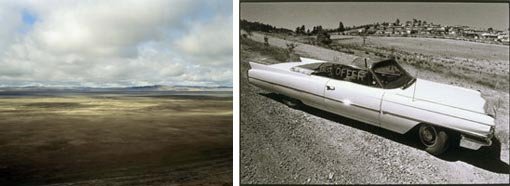Photography & place
Works by 18 Australian photographers, from the 1970s onwards

Left: Debra Phillips Untitled #7 (view from modal plane launch area) 2001 from The world as a puzzle, © Debra Phillips. Image courtesy the artist and BREENSPACE, Sydney. Right: Jon Rhodes Hobart, Tasmania 1972-75 from the album Australia. Art Gallery of New South Wales. Purchased 1980 © Jon Rhodes.
Photography & place presents the work of 18 artists, including Rosemary Laing, Anne Ferran, Michael Riley, Ingeborg Tyssen, Simryn Gill and Ricky Maynard. The range of work included encompasses ideas of place in relation to historical residue, ethnicity, the interface between people and nature, the sublime, as well as the road and the journey in Australian landscape mythologies.
The artists are not necessarily constructing the image; however they do have specific intentions in mind and do conceptualise, compose and consider the craft and process of their work very carefully. What we tend to see in the final print is a metaphor for something. Through presence as much as absence the idea is presented in the simplest possible way.
There is also an implicit acknowledgement of the role of the photographer as a mediator and a story teller, and the story is not at all straightforward. It is not picture postcard perfect.
Since the early 1990s Anne Ferran, for example, has been focusing on places in Australia’s history where women have resided: Rouse Hill, Hyde Park Barracks and most recently, the Female Factories in Tasmania. In the series Lost to worlds 2008 Ferran has documented the bare ground where the Tasmanian Factories once stood. Printed directly onto aluminium, these large scale photographs exhibit the traces of those left behind.
Rosemary Laing’s 2004 panoramic photographs of places such as the Flinders Ranges or Lake Eyre operate within an Australian art historical imperative, as well as independently because of their formal and aesthetic characteristics. Severely pared back if viewed in relation to her earlier series, this work nonetheless approaches similar ideas to do with the history of art and exploration in Australia. The path through the bleached gum trees in After Heysen may have been trod for thousands of years – the symbology of place is not confined to the painters and photographers who visited the area between the World Wars. Further, the idea of heat associated with place is as far removed from the conventional idea of landscape as can be.
Visually linking the natural environment with religious symbolism Michael Riley articulates in the series flyblown 1998, Indigenous spirituality’s connections to country and widens his examination beyond to examine the sustained environmental damage. Riley’s success in articulating these issues and complexities, incorporating religious iconography so burdened by history and meaning, is a testament to his sensitivity and subtlety. Allowing room for ambiguity, Riley provides space for the mixed emotions of the subject and its history.
There are those in Photography & place who deconstruct the view before the camera lens and attempt to reconstruct what can be seen in order to present a less partial depiction of the environment we inhabit. In the 1970s these views included montages of two or more images within the frame, books and the use of Polaroids and Instamatic cameras. From the 1980s onwards artists worked increasingly in series rather than single images, further exploding notions of fixed pictorial codes and perspectives. The journey of discovery ceased to have romantic connotations and became very much a discovery of detail, occasionally cinematic in scale but as often focused on the intimacies of the local.
This exhibition looks at the earlier work from the 1970s and compares and contrasts intention and effect in relation to more recent photography. It examines works which present very specific views of locations and what that location or place can be taken to represent.
Artists included: Simone Douglas, Peter Elliston, Anne Ferran, Simryn Gill, Bill Henson, Douglas Holleley, Rosemary Laing, Marion Marrison, Ricky Maynard, Ian North, Paul Ogier, Debra Phillips, Jon Rhodes, Michael Riley, Lynn Silverman, Wes Stacey, David Stephenson and Ingeborg Tyssen.
On view
16 Mar – 29 May 2011
Art Gallery of New South Wales
Art Gallery Road, The Domain, Sydney
Admission
Free
Media contact
Susanne Briggs
Tel 02 9225 1791
Mob 0412 268 320
susanne.briggs@ag.nsw.gov.au